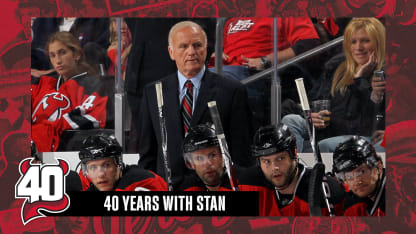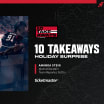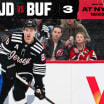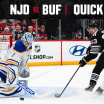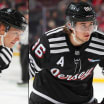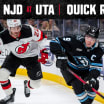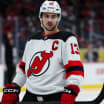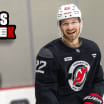When Bowman's boys exulted in their dynastic late 1970s era, nobody on either side of the 49th parallel did anything but rave about Montreal's winning technique, but when the Devils utilized the same blueprint, insults poured south over the border.
But I'll get to that in a minute. First, we must focus on the technique Itself that drove foes nuts and had the (mostly) Canadian critics doing a 180-degree turn from applauding to abhor-ing.
"Lemaire and Robinson didn't bring in a 'new' system," Sullivan correctly pointed out, "it just was that it had been seldom used."
Here's how it evolved on the ice: four players would work the neutral zone while the fifth would invade the enemy ice. The formation would likely force the foe to either lose the puck in the center area or, alternately, force them to relinquish possession by shooting into New Jersey's end of the rink.
Sullivan: "Others simply saw it as a 1-2-2 forechecking system, the one Montreal used ages ago with similarly successful results."
But, if it worked for the Canadiens and nobody beefed about it, how come -- all of a sudden now that Lemaire-Robinson began utilizing it -- newsmen are complaining?
For one thing, the Devils were becoming more and more successful and a threat to traditional winners such as the Habs. The East Rutherford sextet was looked upon as an upstart and, according to some thinking, upstarts should be put in their place.
And so the insults began pouring in with the most damning being testily mentioned -- almost as a semi-curse -- as the"neutral zone trap." It suggested that New Jersey wasn't really interested in scoring but rather to keep the puck out of its net; as if that were a heinous crime.
But the critics were wrong; the Devils were scoring; plenty. In the first month under Lemaire-Robinson, they went into Winnipeg and beat the Jets, 7-4. They would continue the red light trend through the entire season.
Yet, "trap" became a dirty word and it hurt the performers who were so splendidly winning with it. Mister Devil, Ken Daneyko was one who took offense and his words had a genuine feeling from the heart.
"The term 'trap' was something created by the media," Daneyko asserted. "The writers -- for whatever their motives -- wanted to stereotype us. We were winning and they didn't like it."
Kenny was referring mostly -- but not exclusively -- to the Canadian hockey writers who tended to favor teams north of the 49th Parallel.
As the new high command became increasingly successful, the 1993-94 campaign was looming as one where the Devils would establish themselves -- for the very first time -- as a Cup threat.
They were in the elite class not because of any "neutral zone" nonsense but rather because rookie goalkeeper Martin Brodeur was proving to be parsimonious when it came to allowing pucks to pass him.
The arrival of the new year, 1994, brought nothing but a New Jersey ascent to the National Hockey League's upper strata. They entered January on what was to be a 7-2 streak and it only got better heading toward spring. The surge continued In March when they won a dozen games.
"We had balance," Bill Guerin explained. "It wasn't just that our defense was solid or that Marty was on his way to stardom; we had lots of guys who could score goals. Fellas like Stephane Richer, Claude Lemieux, Johnny MacLean, Myself; a whole bunch of us including defense; like Scotty Niedermayer. That trap crap was just a kind of jealous reaction to our success."
They didn't win the Cup that first season of Lemaire-Robinson but they came within a Game Seven, double-overtime of beating the Rangers in June 1994.
Unfortunately, Lemaie's momentum was halted by an October 1994 work stoppage that lasted into the second half of 1994-95. It was not easy for Jacques to get his orchestra back in tune but when it came to playoff time, harmony had returned, and so did the critical barbs.
Some Garden State players were negatively affected more than others. One was New Jersey native Jim Dowd who learned his hockey in Brick; a genuine hometown boy who made good.
In an interview with Sullivan for Battle On Hudson, Dowd was asked about those who disparagingly ripped Lemaie's strategy.
Dowd: "Really a lot of people tried to break down what we were doing, and it was not that hard to figure out. Our transition was simple. Just go play your position. Get the puck and go score.
"We played fundamental hockey that so many other teams were not doing. Our knockers could call it a 'trap' or whatever. Didn't matter to us because we had the puck all the time, And, remember, we had the talent to go with it."
But so did the flamboyant Rangers who finished six points ahead of New Jersey in the final standings and were still the defending Cup champions. Still, the fact that the gang from East Rutherford totalled 106 points on the season was impressive.
Granted, the Blueshirts seven-game triumph and eventual 1994 Stanley victory had temporarily dampened spirits in g.m.Lou Lamoriello's front office. Nor was the lockout any balm. But when labor peace finally was restored, redemption was ahead for Lemaire & Company.
Getting a jump on their foes, the Devils chose to continue skating during the lockout. Their practice rink in South Mountain, New Jersey was available. And, at any given time after the workouts, players could schmooze with Yankees baseball legend, Yogi Berra who -- along with his pal, team owner Dr. John McMullen -- also used the hockey team's training facilities.
When the aborted season finally did begin, the Devils seemed unable to find their groove. Through January and February 1995, they looked more like the Flatwheel Local than the New Jersey Express. They were so eh that even the "trap" critics shut up.
Meanwhile, Lou did what he had to do. He obtained 1980 Miracle On Ice Olympic hero Neal Broten and laser-shooting defenseman Shawn Chambers.
Never in Lamoriello's wildest dreams could he have imagined how meaningful the deals would be. Neither could defenseman Bruce Driver have imagined how easily his teammates turned on the "WIN" switch once the playoffs began in Boston.
Shazam! Just like that, everything neatly jelled at once. This was most evident in the scrimmage before Game 1.
Driver: "It was the most crisp practice we had all year. Everything worked and I'll never be able to figure out how the switch went on. All of a sudden, we were at the top of our game and it didn't matter that the series opened in Boston."
It mattered to the Bruins who lost two straight Brodeur shutouts for an aggregate of 8-0 for New Jersey. The Devils wrapped up the opening round in five games on May 14, 1995, with a 3-2 victory. (Coincidentally, it was the final game played at ancient Boston Garden.
Next up was Pittsburgh and, once again, the Devils opened on the road. The first game loss, 3-2, proved to be a minor pothole. Lemaire's skaters romped through the next four games. Whether it was the "trap" or "neutral zone whatever," New Jersey had the knack; this time with a 15-5 goal aggregate.
"I was feeling more comfortable," said Brodeur. "No such thing as a sophomore slump for me. Plus the guys were playing great hockey in front of me."
But the third-round foe would prove to be another story. The Flyers' hulking captain Eric Lindros was at the top of his game and with the series opening on Broad Street, the Devils big push seemed in danger of a reversal.
No; not yet. A pair of Devils wins -- 4-1 and 5-2 -- appeared to have the latest tourney wrapped up except that Philly invaded East Rutherford and put the series back into a deadlock with a pair of wins.
Game 5 turned into a see-saw affair late in the third period. It was 2-2 and overtime loomed with less than a minute remaining before a sudden death period would follow.
I was standing directly behind the glass directly behind Marty Brodeur's goal when Claude Lemieux began his Galloping Ghost routine along the right boards. I was thinking that the Devils clutch scorer would merely shoot the puck into the enemy zone just to kill the clock before overtime.
"Like everyone else," said Brodeur, "I was wondering what Claude was going to do."
Lemieux thundered past the center red line and, as he approached the Philly blue line, pulled his stick back and, Wham! The missile zoomed at goalie Ron Hextall.
"It's too far," a SportsChannel tech guy commented. "Shouldn't be a big deal stop for Hexy."
That's what I thought as I followed the puck's beeline. Hextall had plenty of time to handle the blast which was not screened. But Hextall must have thought it was a knuckleball. His padded right leg shot out but it never made contact. With just 44 seconds left in the middle stanza, the Devils had the lead, 3-2 -- and the game.
Back home on June 13, 1995, they eliminated Philly 4-2. They had moved on to the Cup Final against a mighty foe, the Detroit Red Wings.
All of sudden, the Devils-bashing brigade came out of the woodwork as the teams arrived in Motor City for the showdown. I was there covering it for SportsChannel; and was an eyewitness to the Jersey-knockers at work.
On the day before Game 1, the NHL sponsored a dual press conference. First, the Red Wings would meet the media with coach Scotty Bowman and a few stars on the dais to answer questions.
After that segment, Detroit players would be distributed - with the press - among about eight tables, to wrap up the Red Wings end of the event.
Next came the Devils and a rather insulting episode. During Detroit's press exchange, the room was packed to the walls. But, once the Red Wings finished and the Devils moved in - the media moved out.
It was almost as if New Jersey was being ignored. Only a handful of reporters remained to talk to the Devils. If an objective visitor didn't know better it would seem as if the scribes had decided in advance that the series was over before it had begun. Some actually did think so.
One Canadian paper ran a headline predicting DETROIT IN FOUR. Another press wag thought he'd get a laugh when he asserted that the Red Wings would wrap it up in three!
Of course, a team loaded with such future Hall of Famers as Steve Yzerman, Sergei Fedorov, and coach Bowman figured to be favored. After all, they had dominated the Western Conference with 33 victories and 70 points. As for the playoffs, the Detroiters had steamrolled to the Final round with an arresting 12-2 mark. Plus the series would open in their friendly Joe Louis Arena.
"We weren't intimidated," said Guerin. "All three of our other series opened on the road. We just took it in stride. We'll do the same thing here."
They also took the two games in Joe Louis Arena, 2-1 and 3-1. The critics could cry about the "Neutral Zone Trap" all they wanted. But it wasn't any "trap" that smothered Detroit, it was young Brodeur out-goaling the veteran Mike Vernon.
The misguided media that accused the Devils of being low-scorers got their comeuppance in Game Three when Lemaire's sharpshooters fired five pucks past Vernon. The 5-2 decision left the pro-Red Wing out-of-town writers stunned to the very core.
Detroit went ahead 1-0 early in Game Four but it turned out to be a tease for the Visitors. The Devils simply went into a higher gear and captured the Cup going away, 5-2.
When Gary Bettman presented the mug to captain Scott Stevens, the Commissioner's message was right on the money.
"The Devils amazing playoff run has taken the word teamwork to a new level." stated Bettman. "Congratulations to the Devils!"
And yet to this day, almost three decades later, the bum rap of "trap" still is heard when the Devils first Cup win is discussed by some misguided media types. They either still don't get it, or don't want to get it.
No, it wasn't the "trap" that did it but the same insightful strategy employed by the Canadiens in the late 1970s when Jacques Lemaire was their leading center and offensive force.
"Jacques was such a big part of it," captain Scott Stevens concluded. "He instilled that belief in the system and once we got going, we were hard to beat."
Stevens didn't have to say it, but I will. The Devils were also super-motivated by the media who said they'd go out in four and that they use this stifling system called "The Trap."
In the end, the only ones trapped were those in the press corps who misinformed their audience with the negative "Trap" talk. Meanwhile, Jacques just ignored them, then sprung his super strategy and led his Devils to victory!

